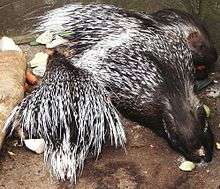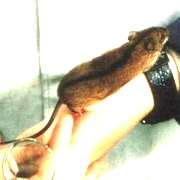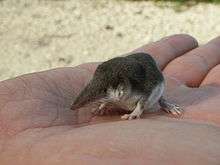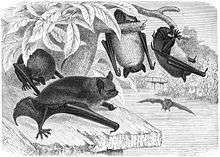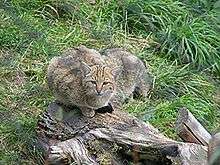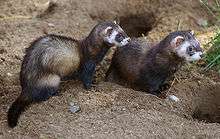List of mammals of Turkey

This is a list of the mammal species recorded in Turkey. There are 127 mammal species in Turkey, of which 2 are critically endangered, 2 are endangered, 14 are vulnerable, and 3 are near-threatened.[1]
The following tags are used to highlight each species' conservation status as assessed by the IUCN:
| EX | Extinct | No reasonable doubt that the very last individual has died. |
| EW | Extinct in the wild | Known only to survive in captivity or as a naturalized populations well outside its previous range. |
| CR | Critically endangered | The species is in imminent risk of extinction in the wild. |
| EN | Endangered | The species is facing an extremely high risk of extinction in the wild. |
| VU | Vulnerable | The species is facing a high risk of extinction in the wild. |
| NT | Near threatened | The species does not meet any of the criteria that would categorise it as risking extinction but it is likely to do so in the future. |
| LC | Least concern | There are no current identifiable risks to the species, and does not require protection of any kind. |
| DD | Data deficient | There is inadequate information to make an assessment of the risks to this species. |
Some species were assessed using an earlier set of criteria. Species assessed using this system have the following instead of near threatened and least concern categories:
| LR/cd | Lower risk/conservation dependent | Species which were the focus of conservation programmes and may have moved into a higher risk category if that programme was discontinued. |
| LR/nt | Lower risk/near threatened | Species which are close to being classified as vulnerable but are not the subject of conservation programmes. |
| LR/lc | Lower risk/least concern | Species for which there are no identifiable risks. |
Subclass: Theria
Infraclass: Eutheria
Order: Rodentia (rodents)
Rodents make up the largest order of mammals, with over 40 percent of mammalian species. They have two incisors in the upper and lower jaw which grow continually and must be keep short by gnawing. Most rodents are small though the capybara can weigh up to 45 kg (100 lb).
- Suborder: Hystricognathi
- Family: Hystricidae (Old World porcupines)
- Genus: Hystrix
- Indian porcupine Hystrix indica LR/lc
- Genus: Hystrix
- Family: Hystricidae (Old World porcupines)
- Suborder: Sciurognathi
- Family: Sciuridae (squirrels)
- Subfamily: Sciurinae
- Tribe: Sciurini
- Genus: Sciurus
- Caucasian squirrel Sciurus anomalus LR/nt
- Red squirrel Sciurus vulgaris LR/lc
- Genus: Sciurus
- Tribe: Sciurini
- Subfamily: Sciurinae
- Subfamily: Xerinae
- Tribe: Marmotini
- Genus: Spermophilus
- European ground squirrel Spermophilus citellus VU
- Asia Minor ground squirrel Spermophilus xanthoprymnus LR/lc
- Taurus ground squirrel Spermophilus taurensis"
- European ground squirrel Spermophilus citellus VU
- Genus: Spermophilus
- Tribe: Marmotini
- Family: Gliridae (dormice)
- Subfamily: Leithiinae
- Genus: Dryomys
- Woolly dormouse Dryomys laniger LR/nt
- Forest dormouse Dryomys nitedula LR/nt
- Genus: Eliomys
- Asian garden dormouse Eliomys melanurus LC
- Genus: Muscardinus
- Hazel dormouse Muscardinus avellanarius LR/nt
- Genus: Myomimus
- Roach's mouse-tailed dormouse Myomimus roachi VU
- Genus: Dryomys
- Subfamily: Glirinae
- Genus: Glis
- Edible dormouse Glis glis LR/nt
- Genus: Glis
- Subfamily: Leithiinae
- Family: Dipodidae (jerboas)
- Subfamily: Allactaginae
- Genus: Allactaga
- Small five-toed jerboa Allactaga elater LR/lc
- Euphrates jerboa Allactaga euphratica LR/nt
- Genus: Allactaga
- Subfamily: Allactaginae
- Family: Spalacidae
- Subfamily: Spalacinae
- Genus: Nannospalax
- Palestine mole rat Nannospalax ehrenbergi LC
- Lesser mole rat Nannospalax leucodon VU
- Nehring's blind mole-rat Nannospalax nehringi LR/lc
- Genus: Nannospalax
- Subfamily: Spalacinae
- Family: Cricetidae
- Subfamily: Cricetinae
- Genus: Cricetulus
- Gray dwarf hamster Cricetulus migratorius LR/nt
- Genus: Cricetus
- European hamster Cricetus cricetus LR/lc
- Genus: Mesocricetus
- Turkish hamster Mesocricetus brandti LR/lc
- Genus: Cricetulus
- Subfamily: Arvicolinae
- Genus: Arvicola
- Water vole Arvicola terrestris LR/lc
- Genus: Chionomys
- Caucasian snow vole Chionomys gud LR/nt
- Snow vole Chionomys nivalis LR/nt
- Robert's snow vole Chionomys roberti LR/nt
- Genus: Clethrionomys
- Bank vole Clethrionomys glareolus LR/lc
- Genus: Ellobius
- Transcaucasian mole vole Ellobius lutescens LR/lc
- Genus: Microtus
- Common vole Microtus arvalis Lr/lc
- Günther's vole Microtus guentheri LR/nt
- Persian vole Microtus irani LR/lc
- Southern vole Microtus rossiaemeridionalis LR/lc
- Social vole Microtus socialis LR/lc
- European pine vole Microtus subterraneus LR/lc
- Genus: Prometheomys
- Long-clawed mole vole Prometheomys schaposchnikowi LR/lc
- Genus: Arvicola
- Subfamily: Cricetinae
- Family: Muridae (mice, rats, voles, gerbils, hamsters, etc.)
- Subfamily: Deomyinae
- Genus: Acomys
- Asia Minor spiny mouse Acomys cilicicus CR
- Genus: Acomys
- Subfamily: Gerbillinae
- Genus: Meriones
- Persian jird Meriones persicus LR/lc
- Tristram's jird Meriones tristrami LR/lc
- Vinogradov's jird Meriones vinogradovi LR/lc
- Genus: Meriones
- Subfamily: Murinae
- Genus: Apodemus
- Striped field mouse Apodemus agrarius LR/lc
- Yellow-necked mouse Apodemus flavicollis LR/lc
- Yellow-breasted field mouse Apodemus fulvipectus LR/lc
- Black Sea field mouse Apodemus ponticus LR/lc
- Wood mouse Apodemus sylvaticus LC
- Ural field mouse Apodemus uralensis LR/lc
- Genus: Micromys
- Harvest mouse Micromys minutus LR/nt
- Genus: Mus
- Macedonian mouse Mus macedonicus LR/lc
- House mouse Mus musculus LR/lc
- Genus: Apodemus
- Subfamily: Deomyinae
- Family: Sciuridae (squirrels)
Order: Lagomorpha (rabbits, hares and picas)
- Family: Leporidae
- Subfamily: Leporinae
- Genus: Lepus
- European hare Lepus europaeus
- Genus: Oryctolagus
- European rabbit Oryctolagus cuniculus
- Genus: Lepus
- Subfamily: Leporinae
- Family: Leporidae
Order: Erinaceomorpha (hedgehogs and gymnures)
The order Erinaceomorpha contains a single family, Erinaceidae, which comprise the hedgehogs and gymnures. The hedgehogs are easily recognised by their spines while gymnures look more like large rats.
- Family: Erinaceidae (hedgehogs)
- Subfamily: Erinaceinae
- Genus: Erinaceus
- Southern white-breasted hedgehog Erinaceus concolor LR/lc
- Genus: Hemiechinus
- Long-eared hedgehog Hemiechinus auritus LR/lc
- Genus: Erinaceus
- Subfamily: Erinaceinae
- Family: Erinaceidae (hedgehogs)
Order: Soricomorpha (shrews, moles, and solenodons)
The "shrew-forms" are insectivorous mammals. The shrews and solenodons closely resemble mice while the moles are stout-bodied burrowers.
- Family: Soricidae (shrews)
- Subfamily: Crocidurinae
- Genus: Crocidura
- Gueldenstaedt's shrew Crocidura gueldenstaedtii LR/lc
- Bicolored shrew Crocidura leucodon LR/lc
- Serezkaya shrew Crocidura serezkyensis LR/lc
- Lesser white-toothed shrew Crocidura suaveolens LR/lc
- Genus: Suncus
- Etruscan shrew Suncus etruscus LC
- Genus: Crocidura
- Subfamily: Soricinae
- Tribe: Nectogalini
- Genus: Neomys
- Southern water shrew Neomys anomalus LR/lc
- Eurasian water shrew Neomys fodiens LR/lc
- Transcaucasian water shrew Neomys schelkovnikovi LR/lc
- Genus: Neomys
- Tribe: Soricini
- Genus: Sorex
- Common shrew Sorex araneus LR/lc
- Eurasian pygmy shrew Sorex minutus LR/lc
- Radde's shrew Sorex raddei LR/lc
- Caucasian shrew Sorex satunini LR/lc
- Caucasian pygmy shrew Sorex volnuchini LR/lc
- Genus: Sorex
- Tribe: Nectogalini
- Subfamily: Crocidurinae
- Family: Talpidae (moles)
- Subfamily: Talpinae
- Tribe: Talpini
- Genus: Talpa
- European mole Talpa europaea LR/lc
- Levantine mole Talpa levantis LR/lc
- Genus: Talpa
- Tribe: Talpini
- Subfamily: Talpinae
Order: Chiroptera (bats)
The bats' distinguishing feature is that their forelimbs are developed as wings, making them the only mammals in the world naturally capable of flight. Bat species account for about 20% of all mammals.
- Family: Pteropodidae (flying foxes, Old World fruit bats)
- Subfamily: Pteropodinae
- Genus: Rousettus
- Egyptian fruit bat Rousettus aegyptiacus LC
- Genus: Rousettus
- Subfamily: Pteropodinae
- Family: Vespertilionidae
- Subfamily: Myotinae
- Genus: Myotis
- Bechstein's bat Myotis bechsteini VU
- Brandt's bat Myotis brandti LR/lc
- Long-fingered bat Myotis capaccinii VU
- Daubenton's bat Myotis daubentonii LR/lc
- Geoffroy's bat Myotis emarginatus VU
- Greater mouse-eared bat Myotis myotis LR/nt
- Whiskered bat Myotis mystacinus LR/lc
- Natterer's bat Myotis nattereri LR/lc
- Genus: Myotis
- Subfamily: Vespertilioninae
- Genus: Barbastella
- Barbastelle Barbastella barbastellus VU
- Genus: Eptesicus
- Botta's serotine Eptesicus bottae LC
- Northern bat Eptesicus nilssoni LR/lc
- Serotine bat Eptesicus serotinus LR/lc
- Genus: Hypsugo
- Savi's pipistrelle Hypsugo savii LR/lc
- Genus: Nyctalus
- Greater noctule bat Nyctalus lasiopterus LR/nt
- Lesser noctule Nyctalus leisleri LR/nt
- Common noctule Nyctalus noctula LR/lc
- Genus: Pipistrellus
- Kuhl's pipistrelle Pipistrellus kuhlii LC
- Nathusius' pipistrelle Pipistrellus nathusii LR/lc
- Common pipistrelle Pipistrellus pipistrellus LC
- Genus: Plecotus
- Brown long-eared bat Plecotus auritus LR/lc
- Grey long-eared bat Plecotus austriacus LR/lc
- Genus: Vespertilio
- Parti-coloured bat Vespertilio murinus LR/lc
- Genus: Barbastella
- Subfamily: Miniopterinae
- Genus: Miniopterus
- Schreibers' long-fingered bat Miniopterus schreibersii LC
- Genus: Miniopterus
- Subfamily: Myotinae
- Family: Molossidae
- Genus: Tadarida
- European free-tailed bat Tadarida teniotis LR/lc
- Genus: Tadarida
- Family: Emballonuridae
- Genus: Taphozous
- Naked-rumped tomb bat Taphozous nudiventris LC
- Genus: Taphozous
- Family: Nycteridae
- Genus: Nycteris
- Egyptian slit-faced bat Nycteris thebaica LC
- Genus: Nycteris
- Family: Rhinolophidae
- Subfamily: Rhinolophinae
- Genus: Rhinolophus
- Blasius's horseshoe bat Rhinolophus blasii NT
- Mediterranean horseshoe bat Rhinolophus euryale VU
- Greater horseshoe bat Rhinolophus ferrumequinum LR/nt
- Lesser horseshoe bat Rhinolophus hipposideros LC
- Mehely's horseshoe bat Rhinolophus mehelyi VU
- Genus: Rhinolophus
- Subfamily: Rhinolophinae
- Family: Pteropodidae (flying foxes, Old World fruit bats)
Order: Cetacea (whales)
The order Cetacea includes whales, dolphins and porpoises. They are the mammals most fully adapted to aquatic life with a spindle-shaped nearly hairless body, protected by a thick layer of blubber, and forelimbs and tail modified to provide propulsion underwater.
Species listed below also includes species being recorded in Levantine Sea except for gray whale.
- Suborder: Mysticeti
- Family: Balaenopteridae
- Genus: Balaenoptera
- Blue whale Balaenoptera m. musculus EN (possible)[2]
- Fin whale Balaenoptera physalus EN
- Common minke whale Balaenoptera acutorostrata LC [3][4]
- Genus: Balaenoptera
- Family: Balaenopteridae
- Subfamily: Megapterinae
- Genus: Megaptera
- Humpback whale Megaptera novaeangliae LC[5]
- Family: Balaenidae
- Genus: Eubalaena
- North Atlantic right whale Eubalaena glacialis CR (possible)[6]
- Genus: Eubalaena
- Genus: Megaptera
- Suborder: Odontoceti
- Family: Physeteridae (sperm whales)
- Genus: Physeter
- Sperm whale Physeter macrocephalus VU[7]
- Family: Ziphidae
- Genus: Ziphius
- Cuvier's beaked whale Ziphius cavirostris DD[8]
- Genus: Ziphius
- Genus: Mesoplodon
- Gervais' beaked whale Ziphius cavirostris DD
- Genus: Physeter
- Superfamily: Platanistoidea
- Family: Phocoenidae
- Genus: Phocoena
- Harbour porpoise Phocoena phocoena VU
- Genus: Phocoena
- Family: Delphinidae (marine dolphins)
- Genus: Tursiops
- Common bottlenose dolphin Tursiops truncatus DD
- Genus: Delphinus
- Short-beaked common dolphin Delphinus delphis LC
- Genus: Stenella
- Striped dolphin Stenella coeruleoalba LR/cd[9]
- Pantropical spotted dolphin Stenella attenuata LR/cd (possible)[5]
- Genus: Sousa
- Genus: Grampus
- Risso's dolphin Grampus griseus DD
- Genus: Orcinus
- Orca Orcinus orca DD
- Genus: Pseudorca
- False killer whale Pseudorca crassidens LR/lc[9]
- Genus: Globicephala
- Long-finned pilot whale Globicephala melas LR/lc[9]
- Genus: Tursiops
- Family: Monodontidae
- Genus: Delphinapterus
- Family: Phocoenidae
- Family: Physeteridae (sperm whales)
Order: Carnivora (carnivorans)


There are over 260 species of carnivorans, the majority of which feed primarily on meat. They have a characteristic skull shape and dentition.
- Suborder: Feliformia
- Family: Felidae (cats)
- Subfamily: Felinae
- Genus: Caracal
- Caracal Caracal caracal LC
- Genus: Felis
- Jungle cat Felis chaus LC
- Wildcat Felis silvestris LC
- Genus: Lynx
- Eurasian lynx Lynx lynx NT
- Genus: Acinonyx
- Asiatic cheetah Acinonyx jubatus venaticus CR - regionally extinct
- Genus: Caracal
- Subfamily: Pantherinae
- Genus: Panthera
- Persian leopard Panthera pardus ciscaucasica EN
- Asiatic lion Panthera leo persica EN - regionally extinct
- Caspian tiger Panthera tigris virgata EX
- Genus: Panthera
- Subfamily: Felinae
- Family: Herpestidae (mongooses)
- Genus: Herpestes
- Egyptian mongoose Herpestes ichneumon LR/lc
- Genus: Herpestes
- Family: Hyaenidae (hyaenas)
- Genus: Hyaena
- Striped hyena Hyaena hyaena LR/nt
- Genus: Hyaena
- Family: Felidae (cats)
- Suborder: Caniformia
- Family: Canidae (dogs, foxes)
- Family: Ursidae (bears)
- Genus: Ursus
- Brown bear Ursus arctos LR/lc
- Genus: Ursus
- Family: Mustelidae (mustelids)
- Genus: Mustela
- Stoat Mustela erminea LR/lc
- Least weasel Mustela nivalis LR/lc
- European polecat Mustela putorius LR/lc
- Genus: Vormela
- Marbled polecat Vormela peregusna LR/lc
- Genus: Martes
- Beech marten Martes foina LR/lc
- Pine marten Martes martes LR/lc
- Genus: Meles
- Eurasian badger Meles meles LR/lc
- Genus: Lutra
- European otter Lutra lutra NT
- Genus: Mustela
- Family: Phocidae (earless seals)
- Genus: Monachus
- Mediterranean monk seal Monachus monachus CR
- Genus: Monachus
Order: Perissodactyla (odd-toed ungulates)
The odd-toed ungulates are browsing and grazing mammals. They are usually large to very large, and have relatively simple stomachs and a large middle toe.
- Family: Equidae (horses etc.)
- Genus: Equus
- Syrian wild ass Equus hemionus hemippus EX
- Genus: Equus
Order: Artiodactyla (even-toed ungulates)
Even-toed ungulates' weight is borne about equally by the third and fourth toes, rather than mostly or entirely by the third as in perissodactyls. There are about 220 artiodactyl species, including many that are of great economic importance to humans.
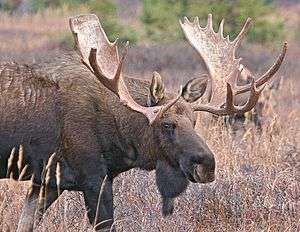
- Family: Suidae
- Family: Cervidae (deer)
- Subfamily: Cervinae
- Genus: Cervus
- Red deer Cervus elaphus LR/lc
- Genus: Dama
- Fallow deer Dama dama LR/lc
- Persian fallow deer Dama dama mesopotamica EX
- Genus: Cervus
- Subfamily: Capreolinae
- Genus: Capreolus
- Roe deer Capreolus capreolus LR/lc
- Genus: Alces
- Caucasian moose Alces alces caucasicus EX
- Genus: Capreolus
- Subfamily: Cervinae
- Family: Bovidae
- Subfamily: Antilopinae
- Genus: Gazella
- Goitered gazelle Gazella subgutturosa VU
- Mountain gazelle Gazella gazella VU
- Genus: Bison
- Caucasian wisent Bison bonasus caucasicus EX
- Genus: Gazella
- Subfamily: Caprinae
- Subfamily: Antilopinae
See also
- Wildlife of Turkey
- List of chordate orders
- List of regional mammals lists
- List of prehistoric mammals
- Mammal classification
- New mammal species
Notes
- ↑ This list is derived from the IUCN Red List which lists species of mammals and includes those mammals that have recently been classified as extinct (since 1500 AD). The taxonomy and naming of the individual species is based on those used in existing Wikipedia articles as of 21 May 2007 and supplemented by the common names and taxonomy from the IUCN, Smithsonian Institution, or University of Michigan where no Wikipedia article was available.
- 1 2 Frantzis A., Alexiadou P., Paximadis G., Politi E., Gannier A., Corsini-Foka M. (2003). "Current knowledge of the cetacean fauna of the Greek Seas" (pdf). Journal of Cetacean Research and Management. International Whaling Commission. 5 (3): 219–232. Retrieved 2016-04-16.
- ↑ Stranding of a minke whale on the eastern Mediterranean coast of Turkey.
- ↑ Киты в Черном море (cached)
- 1 2 Update on the Cetacean Fauna of the Mediterranean Levantine Basin
- ↑ Monsarrat S., Pennino G. M., Smith D. T., Reeves R.R., Meynard N. C., Kaplan M. D., Rodrigues L. S. A. (2015). "Historical summer distribution of the endangered North Atlantic right whale (Eubalaena glacialis): a hypothesis based on environmental preferences of a congeneric species" (pdf). A Journal of Conservation Biogeography - Diversity and Distributions, (Diversity Distrib.). 21: 925–937. Retrieved 2016-04-21.
- ↑ Mediterranean Whale Spotted off Dead Sea Coast
- ↑ 2016. New Publication: New records of Cuvier’s beaked whales (Ziphius cavirostris) from the Turkish Levantine Sea
- 1 2 3 Street Boys of the Bosphorus - Dolphins in Istanbul Strait
References
- "The IUCN Red List of Threatened Species: Mammals of Turkey". IUCN. 2001. Retrieved 22 May 2007.
- "Mammal Species of the World". Smithsonian National Museum of Natural History. 2005. Archived from the original on 27 April 2007. Retrieved 22 May 2007.
- "Animal Diversity Web". University of Michigan Museum of Zoology. 1995–2006. Retrieved 22 May 2007.
